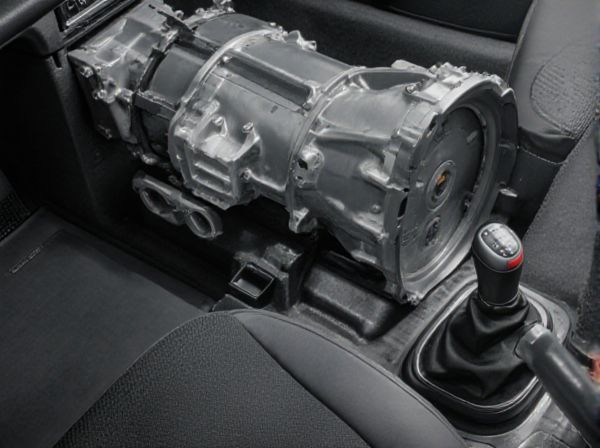
Photo illustration: Column-shift Transmission vs Floor-shift Transmission
Column-shift transmission offers a traditional gear-changing mechanism mounted on the steering column, freeing up floor space and providing easier access in vehicles with bench seats. Floor-shift transmission places the gear lever between the driver and passenger seats, allowing for quicker, more precise gear changes often preferred in performance or sports vehicles. Your choice depends on vehicle type, driving comfort, and interior design preferences.
Table of Comparison
| Feature | Column-shift Transmission | Floor-shift Transmission |
|---|---|---|
| Location | Mounted on steering column | Mounted on vehicle floor |
| Common in | Older vehicles, trucks, classic cars | Sports cars, modern manual vehicles |
| Gear shifting | Longer lever travel, less precise | Shorter lever travel, more precise |
| Space Utilization | More cabin space, allows wide center console | Less cabin space, center console occupies space |
| Driving Experience | Less engaging, easier for casual driving | More engaging, preferred by enthusiasts |
| Maintenance | Simple linkage mechanism | Complex linkage, requires precise adjustment |
Introduction to Transmission Shifter Types
Column-shift transmission and floor-shift transmission represent two distinct types of manual gear shifters primarily used in vehicles. Column-shift transmissions feature the gear lever mounted on the steering column, offering more cabin space and easier access, commonly found in trucks and older cars. Floor-shift transmissions position the gear lever on the vehicle floor, providing more direct linkage and precise shifting, widely favored in performance and sports cars.
What is a Column-shift Transmission?
A column-shift transmission features a gear lever mounted on the steering column, allowing drivers to change gears without moving their hands far from the wheel. This design was popular in older vehicles, offering more cabin space by freeing up the floor area. Unlike floor-shift transmissions, which have a gear lever positioned on the vehicle's floor, column-shift transmissions typically support automatic or manual gearboxes with fewer gear options.
What is a Floor-shift Transmission?
Floor-shift transmission refers to a manual or automatic gear shifting mechanism located on the vehicle's floor, typically between the driver and passenger seats, allowing for more ergonomic and intuitive gear selection. Unlike column-shift transmission, which positions the gear selector on the steering column, floor-shift designs promote quicker and more precise shifting, enhancing driver control and performance. This configuration is commonly found in sports cars, trucks, and performance vehicles due to its direct and responsive handling characteristics.
Historical Evolution of Gear Shifters
Column-shift transmissions initially dominated automotive design in the early 20th century, offering space-saving mechanics and easy accessibility, primarily seen in vehicles like the Ford Model T. The historical shift to floor-shift transmissions emerged in the mid-20th century, driven by the demand for more precise gear control and ergonomic driving experiences, prominently featured in sports cars and performance vehicles. Modern gear shifters reflect this evolution, balancing vintage column shift aesthetics with the advanced functionality and comfort of contemporary floor-shift designs.
Design and Ergonomics Comparison
Column-shift transmissions feature a gear lever mounted on the steering column, saving cabin space and offering more legroom compared to floor-shift transmissions, which have a gear lever located between the driver and passenger seats. Ergonomically, floor-shift transmissions provide more natural hand positioning and quicker shifting movements, enhancing driver control and comfort during spirited or precise driving. The column-shift design prioritizes ease of entry and exit in tight cabins, while floor-shift layouts emphasize a direct, tactile interface aligned with performance driving demands.
Driving Experience: Column vs. Floor Shifters
Column-shift transmissions offer a more spacious cabin by freeing up the center console area, promoting a classic driving feel often preferred in vintage or larger vehicles. Floor-shift transmissions provide a sportier, more precise shifting experience, enhancing driver engagement and control, especially in performance-oriented cars. The tactile feedback and direct shift pattern of floor shifters improve gear selection accuracy compared to the often less intuitive column shifters.
Performance and Efficiency Differences
Column-shift transmissions typically offer quicker gear changes due to their direct linkage design, enhancing mechanical efficiency and driver control in urban or stop-and-go driving conditions. Floor-shift transmissions provide more precise shifting and better ergonomics for performance driving, allowing smoother gear transitions and potentially improving acceleration and fuel efficiency at higher speeds. The choice between the two affects overall vehicle responsiveness, with floor-shift systems often preferred for sporty driving and column-shift setups favored for ease of use in casual or commercial vehicles.
Maintenance and Durability Factors
Column-shift transmissions typically feature simpler mechanical linkages, which can reduce maintenance frequency but may lead to increased wear due to less precise shifting mechanisms compared to floor-shift transmissions. Floor-shift transmissions often provide enhanced durability with more direct and robust linkage designs, allowing for smoother gear changes and reduced mechanical stress over time. Maintenance tasks for floor-shift systems generally involve easier access to components, resulting in quicker repairs and potentially longer transmission lifespan under rigorous driving conditions.
Situational Suitability and Popularity
Column-shift transmissions are often favored in commercial vehicles and trucks due to their space-saving design and ease of use in crowded cabins, making them suitable for professional drivers who require frequent gear changes. Floor-shift transmissions are popular in sports cars and passenger vehicles for their precise control and ergonomic positioning, enhancing driving performance and comfort. The choice between column-shift and floor-shift transmissions heavily depends on vehicle type and driver preference, with floor-shifts dominating in performance-oriented markets and column-shifts prevalent in utility and fleet applications.
Conclusion: Choosing the Right Transmission Shifter
Column-shift transmissions offer increased cabin space and ease of access, ideal for larger vehicles and drivers seeking comfort. Floor-shift transmissions provide more precise control and sportier handling, preferred by performance enthusiasts and vehicles with center consoles. Selecting the right transmission shifter depends on vehicle type, driver preference, and ergonomic considerations.
 caratoz.com
caratoz.com